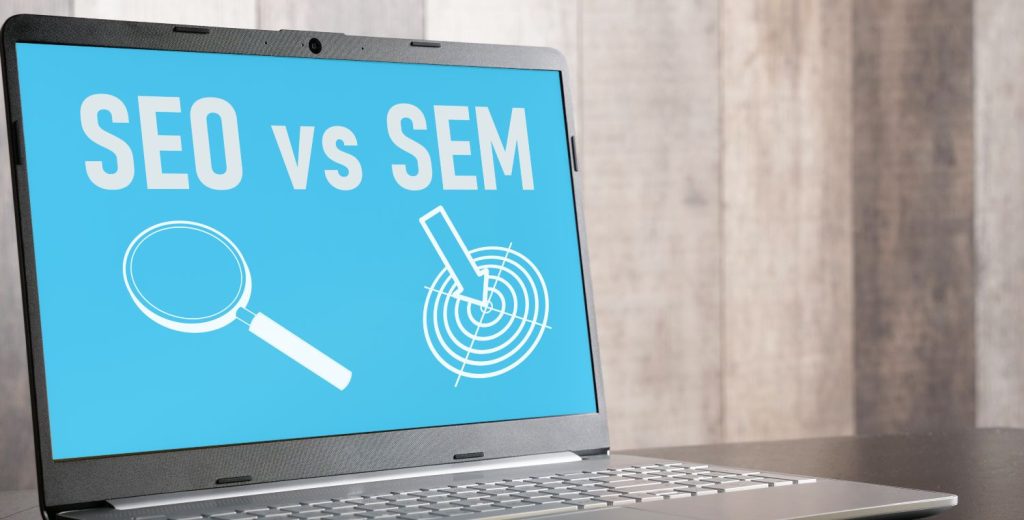
Many people, even those successful in business, do not really understand the Google search results page.
SEO and Google Ads are two different entities. Both can complement each other and work well together.
Ad results normally appear at the top of the SERP, right above organic results.
What Is SEO?
You can use SEO to appear in front of your ideal customers in the organic results based on the keywords they use during a search.
Benefits of digital marketing using SEO strategies including:
- Ranking ahead of competitors
- Appearing at the top on search result pages
- Generating quality website traffic
- Generating quality leads
- Increasing sales
- Generating brand awareness and recognition
- Becoming a credible resource within your industry
- Gaining brand trust and loyalty
However, you’ll need to use different types of SEO to improve your rankings. Note, that it can take time before your rankings improve but often you can see an improvement in traffic after one month.
Types of SEO
On-page SEO
On-page SEO involves factors you can influence within your content. For example, keyword placement plays a part in helping you rank for specific keywords. As part of your SEO strategy, you’ll also need to gather keyword research.
Otherwise, you might not create content that aligns with the user’s search intent. Their search intent can help you meet their expectations. If your content doesn’t meet their expectations, the visitor will leave without exploring your content.
Off-page SEO
Off-page SEO involves factors outside of your website. For example, you’ll need to generate quality backlinks. Backlinks are links that refer readers on other websites to your content.
Gaining backlinks from websites with higher search engine rankings can help your search engine rankings improve. Each backlink is like a vote of confidence for your website.
Technical SEO
Technical SEO involves the backend of your website. For example, you’ll need to improve your website development to ensure the site is fast, mobile-optimized, and secure. The user experience on your website can also impact your organic rankings.
Local SEO
You can rank for location-based keywords to appear in front of local consumers. You can also optimize your Google Business listing and begin generating reviews as part of your local SEO strategy.
What Is SEM?
With SEM, you can improve your rankings on search engines faster than you can with SEO. You can also target consumers based on demographics like age, gender, or location. More precise targeting can help you control your advertising spend.
However, with SEM, you usually pay when people view or click on your ads. The cost-per-click (CPC) can vary based on bids from other businesses.
When someone clicks on one of your ads, they’ll reach a landing page on your website. Then, you can use compelling CTA language to convert that visitor into a lead or sale.
Types of SEM
SEM includes all forms of paid search advertising, including:
- Pay-per-click (PPC)
- Retargeting
- Mobile search advertising
- Google Ads
- Bing Ads
- Product Listing Ads
- Google Shopping ads
- YouTube
- Video search ads
- Amazon Ads
You can use Google Ads to begin appearing on Google search engine result pages or websites on Google’s Search Network. Google Ads allows you to create text and display ads.
Text ads can appear among organic listings on search engine result pages. Display ads can appear on other websites on Google’s network.
Display ads can appear as images, animations, videos, or HTML-5 ads. With display ads, you’ll pay for every 1,000 impressions (cost-per-impression or CPM).
The Difference Between SEO and SEM
You can generate results faster with SEM than you would with SEO. However, once you improve your organic rankings, you can reap the benefits of SEO long-term.
SEM services can benefit your SEO strategy, and vice versa.
For example, you can check the data from your PPC campaigns to determine what search terms people use before clicking on your ads. Then, you can use those keywords within your SEO blog posts.
Once you begin generating traffic from your SEM campaigns, Google might boost your organic rankings, too.
The changes you make to your website for your technical SEO strategy can improve the landing page experience on your website. Google considers the landing page experience when determining your quality score. A better quality score can benefit your CPC.
To recap, what is the biggest difference between SEO and SEM? SEO is an organic strategy while other forms of SEM are paid advertising strategies. Using both, however, can help you gain more brand visibility online.

